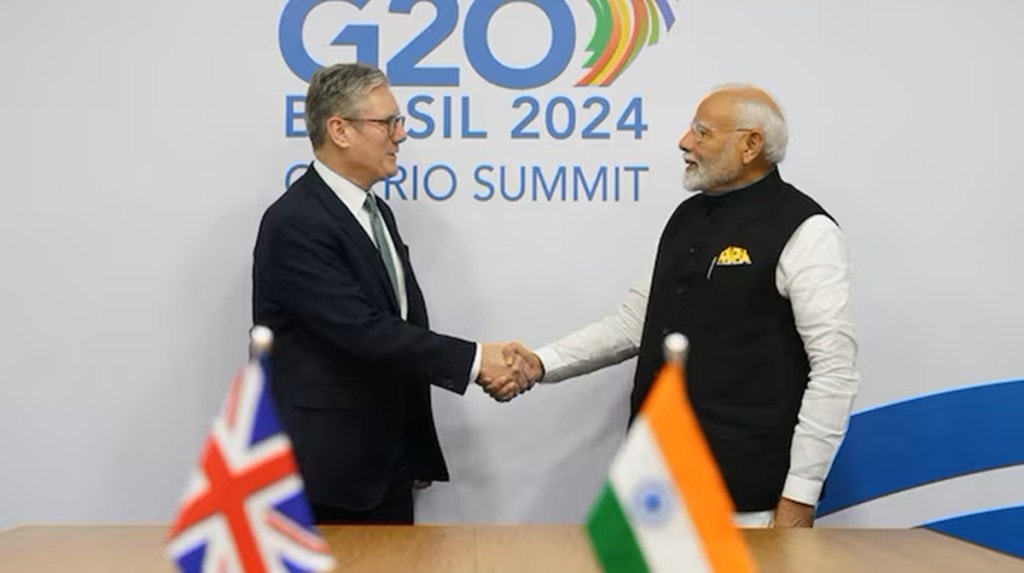By Biswajit Dhar, Distinguished professor, Council for Social Development, New Delhi
After more than three years of intensive negotiations, India and the UK finally wrapped up their bilateral free trade agreement (FTA), which leaders of both countries described as “a historic milestone in the bilateral Comprehensive Strategic Partnership that would foster trade, investment, innovation, and job creation in both the economies”. The two expect this FTA “to significantly enhance bilateral trade, generate new avenues for employment, raise living standards, and improve the overall well-being of citizens in both countries”.
These expectations of mutual benefit from a trade deal rings refreshingly different from the trade agreements that US President Donald Trump is trying to negotiate with several partner countries, including India. While the Trump administration’s objective is to negotiate FTAs to secure benefits solely for the American stakeholders, the India-UK FTA focuses on benefit accruing to both partners from the opening of markets.
India’s FTA with the UK is significant, especially because it is the first among several FTAs that India would formalise with a number of key partners, including the US and the European Union. If these two FTAs are finalised, as they are likely to in the ensuing months, almost one-half of India’s total trade would be conducted with FTA partners. This is a remarkable turnaround for a country which was an FTA-sceptic just over two decades ago.
Though the entire details of the India-UK FTA are not yet available, estimates available from the UK’s Department for Business and Trade (DBT) shows that by 2040, the FTA would increase two-way trade between the two nations by $32 billion. Thus, within the next decade and a half, India-UK trade should expand 2.5 times, reversing the declining importance of the UK as India’s trade partner since the turn of the millennium. In 2000-01, the UK’s share in India’s total trade was 5.8%, making it the second largest partner. But when the decision to negotiate the FTA was taken in 2021, this figure had bottomed out at 1.7%. The FTA negotiations provided some momentum to the trade dynamics between the two countries, and as a result the UK’s share had increased to almost 2% in the first 10 months of the previous fiscal year.
It is clear from the available information on the outcome of the FTA negotiations that the agreement provides comprehensive market access for goods to both countries through deep cuts in tariffs across all sectors. India is looking to gain from tariff elimination on about 99% of the tariff lines covering almost all of its trade with the UK. It is expected that such tariff reductions would impart positive momentum to manufacturing industries across labour- and technology-intensive spectrums. This would open up export opportunities for major industries, including textiles, marine products, leather, footwear, sports goods and toys, gems and jewellery, besides engineering goods, auto parts and engines, and organic chemicals.
India’s more substantive gains are expected through its services trade with the UK, which has offered a slew of concessions in sectors such as information technology (IT)/IT-enabled services, financial services, professional services, other business services and educational services — areas where India has consistently sought concessions from its FTA partners. A major gain is the exemption granted to Indian workers temporarily employed in the UK and their employers from paying social security contributions there for a period of three years under the “Double Contribution Convention”. This exemption should result in significant financial gains for Indian service providers, enhancing their competitiveness in the UK market.
On the other hand, India’s tariffs will see steep reductions, locking in reductions on 90% of tariff lines. Further, 85% of India’s tariffs lines would be tariff-free within a decade. Tariffs on whisky and gin would be halved from the existing 150% to 75%, and by the 10th year of the FTA’s implementation, tariff would be reduced to 40%. India has offered the most significant concession in the industrial sector through reduction of tariffs on automobiles, from the current 100% to 10%, although by when this reduction will happen is not known.
In past FTA negotiations, the Indian government was steadfastly opposed to opening this sector to import liberalisation. It had accepted the automobile industry’s argument that given its relatively smaller scale of operations in India, it would not be able to compete with the global players. However, the government has provided some comfort to the domestic players by ensuring that there would be an import quota while tariff reduction occurs, thus preventing a surge of British cars in the Indian market, at least in the near future.
A major gain for the UK would come from the participation of its businesses in India’s government procurement market, estimated at $51 billion a year. India has opened this sector to enable the UK’s businesses to compete for a range of goods, services, and construction procurements, for a majority of central government entities, as well as for several central public sector undertakings. Thus far, government procurement was out of bounds for foreign businesses to enable the small and medium-sized enterprises, which are the largest providers of jobs in the country, to operate in this sector without having to face competition from large foreign businesses.
While the India-UK FTA promises benefits to both partners, a preliminary assessment of the relative gains by the UK’s DBT indicates that of the $32 billion increase in trade flows expected by 2040, the UK’s share would be nearly $20 billion, and India’s share would be $12 billion. The DBT’s assessment aside, Indian enterprises can turn the agreement in their favour if they take full advantage of the immense opportunities that the India-UK FTA offers.


